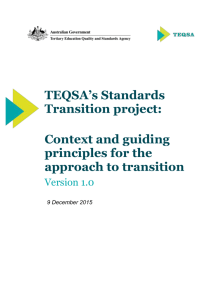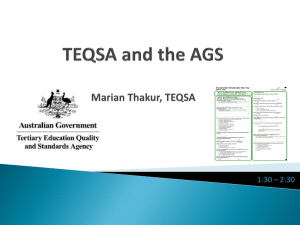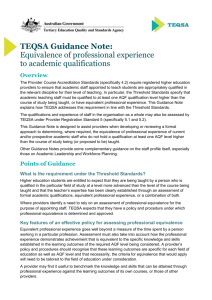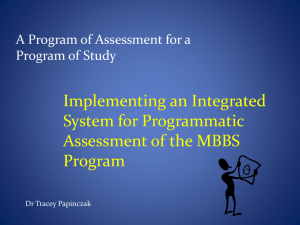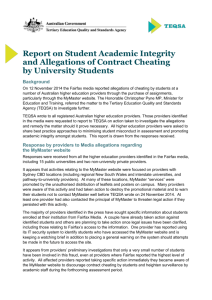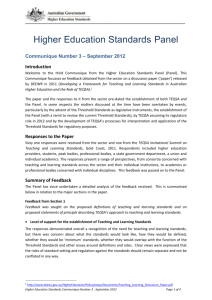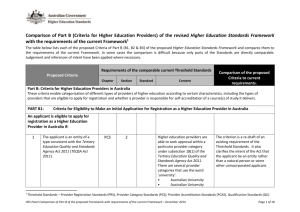TEQSA Cost Recovery Implementation Statement 2015
advertisement
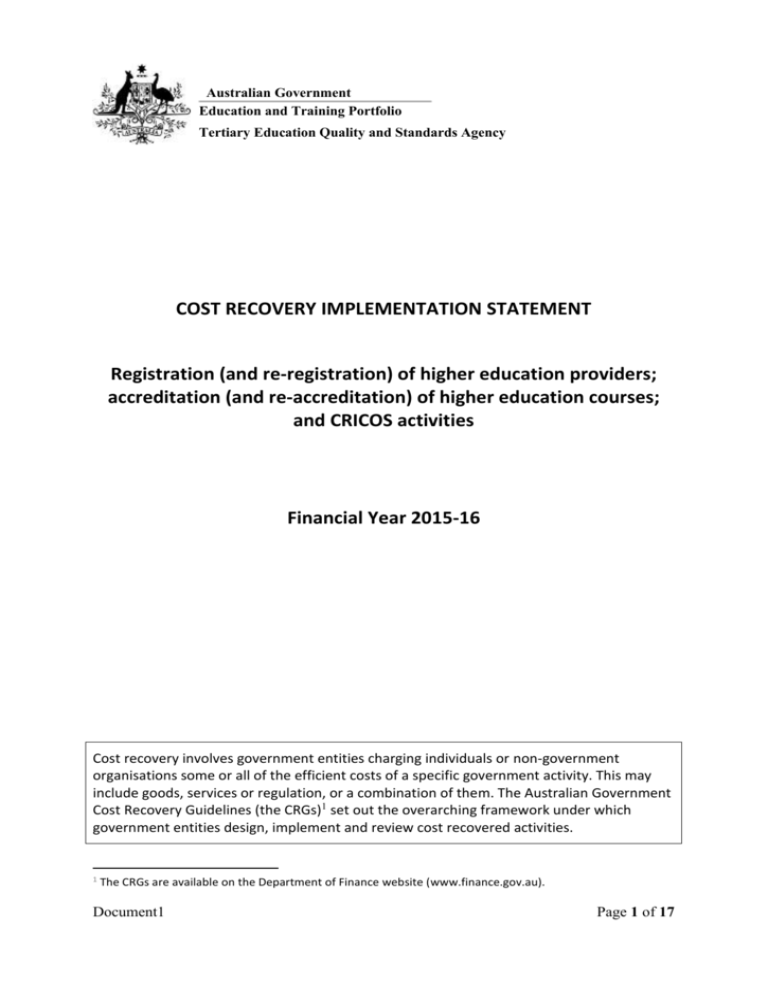
Australian Government Education and Training Portfolio Tertiary Education Quality and Standards Agency COST RECOVERY IMPLEMENTATION STATEMENT Registration (and re-registration) of higher education providers; accreditation (and re-accreditation) of higher education courses; and CRICOS activities Financial Year 2015-16 Cost recovery involves government entities charging individuals or non-government organisations some or all of the efficient costs of a specific government activity. This may include goods, services or regulation, or a combination of them. The Australian Government Cost Recovery Guidelines (the CRGs)1 set out the overarching framework under which government entities design, implement and review cost recovered activities. 1 The CRGs are available on the Department of Finance website (www.finance.gov.au). Document1 Page 1 of 17 1. 1.1 INTRODUCTION Purpose of the CRIS This Cost Recovery Implementation Statement (CRIS) provides information on how the Tertiary Education Quality and Standards Agency (TEQSA) implements cost recovery for registration (and re-registration) of higher education providers; accreditation (and reaccreditation) of higher education courses; and applications in relation to Commonwealth Register of Institutions and Courses for Overseas Students (CRICOS). It also reports financial and non-financial performance information for these activities and contains financial forecasts for 2015-16. As TEQSA has not yet undertaken a detailed activity based costing exercise as part of a broader review of its cost recovery arrangements, of necessity the costing information contained in this CRIS is high level, being at an agency/regulatory business unit level of detail only. TEQSA will update this CRIS when there are further changes to its cost recovery arrangement (for example as the result of a detailed activity based costing exercise) or when there are updates to the reported financial or non- financial information. This is the first CRIS that TEQSA has prepared under the Australian Government Cost Recovery Guidelines (July 2014). 1.2 Description of the activity TEQSA is an independent statutory authority established under the Tertiary Education Quality and Standards Agency Act 2011 (TEQSA Act) and sits within the Education and Training portfolio. TEQSA commenced regulatory functions on 29 January 2012. As the national body for higher education quality assurance and regulation, TEQSA’s focus is on ensuring that higher education providers meet required standards, as well as on promoting best practice self-assurance and enhancing the quality of higher education provision. TEQSA has the power to regulate higher education providers and monitor the quality of Australia’s large, diverse and complex higher education sector comprising public and private universities, Australian branches of overseas universities, and other higher education providers with and without self-accrediting authority. TEQSA is responsible for the registration and re-registration of all higher education providers, and the accreditation and re-accreditation of higher education courses offered by providers without self-accrediting authority. TEQSA only charges for those outputs that a provider specifically requests, namely registration and re-registration, accreditation and re-accreditation, and major variations to registration and/or accreditation. Document1 Page 2 of 17 TEQSA also has responsibility for registration, compliance and full enforcement functions under the Education Services for Overseas Students Act 2000 (ESOS Act) for the higher education sector. TEQSA is required to approve higher education providers and the courses they wish to offer to overseas students on CRICOS, which provides details of all education providers approved to recruit, enrol and deliver education and training services to overseas students, and details of their courses. TEQSA charges an application fee for an approved higher education provider wanting to register to provide a course of study to overseas students or to renew their registration. Currently, no fee is charged for adding a course of study to a provider’s registration on CRICOS. Similar to fees charged for outputs under the TEQSA Act, TEQSA only charges for those CRICOS applications that a provider specifically requests. In addition, all education providers, including higher education providers, of CRICOS courses have levies (annual registration charge and an entry to market charge) imposed on them by the Education Services for Overseas Students (Registration Charges) Act 1997. The Portfolio Department of Education and Training administers this Act and the collection of levies. The Department of Education and Training is responsible for preparing the CRIS for CRICOS fees for 2015-16, given that multiple agencies (ASQA and TEQSA) and the Department are involved in charging fees for CRICOS matters. The Department CRIS for CRICOS fees will however refer to the TEQSA CRIS for information on cost recovery activities or appropriations, to ensure there is no overlap of information. 2. 2.1 POLICY AND STATUTORY AUTHORITY TO COST RECOVER Government policy approval to cost recover the activity TEQSA was established under the Tertiary Education Quality and Standards Agency Act 2011 (the Act) and commenced regulatory functions on 29 January 2012. The Act confers powers and functions on TEQSA to: register regulated entities as registered higher education providers and accredit courses of study conduct compliance assessments and quality assessments conduct accreditation assessments of accredited courses provide advice and make recommendations to the Minister on matters relating to the quality or regulation of higher education providers collect, analyse, interpret and disseminate information relating to quality assurance practice and quality improvement in higher education cooperate with similar agencies in other countries. Document1 Page 3 of 17 The Australian Government allowed TEQSA to charge fees to higher education providers on a cost recovery basis for the following activities (2011-12 Budget Paper No.2 refers): - registration and re‑registration of providers; - accreditation and re‑accreditation of courses; - major variations to registrations and accreditations; and - publication and provision of training programs. TEQSA also has responsibility, as a designated authority under the Education Services for Overseas Students Act 2000, for English Language Intensive Course for Overseas Students providers if they have an entry arrangement with a registered higher education provider, and for Foundation Programme providers. Under this Act, TEQSA has responsibility for registration, compliance and full enforcement functions for the higher education sector. TEQSA is required to approve higher education providers and the courses they wish to offer to overseas students on CRICOS, which provides details of all education providers approved to recruit, enrol and deliver education and training services to overseas students, and details of their courses. 2.2 Statutory authority to charge Section 158 of the TEQSA Act gives TEQSA the authority to determine fees that it may charge for things done in the performance of its functions. TEQSA may determine the way in which a fee is to be worked out and the circumstances in which fees may be paid. Before making an instrument under section 158, TEQSA must obtain the Minister’s approval to the making of the instrument. Document1 Page 4 of 17 3. 3.1 COST RECOVERY MODEL Outputs and business processes of the activity TEQSA’s role is to assure that quality standards are being met by all registered higher education providers. It does this primarily through registration/re-registration processes for all providers and through course accreditation/re-accreditation processes for providers without selfaccrediting authority. In these processes, which recur up to every seven years, TEQSA considers the providers’ track record and applies a range of assessment methods so that it is satisfied, as required under TEQSA Act, that providers meet and continue to meet the national standards. In carrying out its role, TEQSA’s approach is underpinned by three principles – regulatory necessity, reflecting risk and proportionate regulation. TEQSA’s exercise of power therefore differentiates between providers that have extensive positive track records and low risk of future non-compliance, and those that have poor or limited track records and a substantial risk of future non-compliance under the standards. TEQSA not only takes a provider’s record and risks of future non-compliance into account, but also ensures that any exercise of its powers is proportionate to any actual non-compliance and/or risk of future non-compliance. TEQSA places emphasis on promoting and facilitating a culture of effective self-assurance by providers. TEQSA applies a consistent framework for the whole sector and the application of that framework results in differential treatment of providers, reflecting differential risk. TEQSA’s case managers play an important role in applying this framework to each provider. The scope of the assessment and evidence requirements is tailored to the risk profile and track record of each provider. For providers that are applying for initial registration, TEQSA will always undertake an assessment against the full range of Threshold Standards. As described in section 2.2, section 158 of the TEQSA Act gives TEQSA the authority to determine fees that it may charge for things done in the performance of its functions (subject to the Minister’s approval). The Determination of Fees No. 3 of 2013 lists the 15 activities for which a fee is imposed. These are listed in Table 1. Additionally, TEQSA does not undertake all activities it has policy approval to charge for, for example, TEQSA does not provide training programs. Also, TEQSA does not currently charge for a range of activities for CRICOS, for example, adding courses on CRICOS (this fee was removed as the cost of collecting the fee in its current form was higher than the amount recovered, per the Explanatory Statement for Determination of Fees No. 3 of 2013). Document1 Page 5 of 17 Table 1 – Schedule A - Activities for which a fee is imposed (from the Determination of Fees No. 3 of 2013) Item 1 2 3 4 5 6 Document1 Activity for which the fee is imposed Preliminary Assessment of Application for registration as a higher education provider – s 19 of the Act Where the application is for registration in one of the following provider categories: Australian University; Overseas University; Australian University College; Australian University of Specialisation; and Overseas University of Specialisation. Preliminary Assessment of Application for registration as a higher education provider – s 19 of the Act Where the application is for registration in the Higher Education Provider category Substantive Assessment of Application for registration as a higher education provider – s 20 of the Act Where the application is assessed by TEQSA, pursuant to paragraph 19(1)(a) of the Act, as appropriate for one of the following provider categories: Australian University; Overseas University; Australian University College; Australian University of Specialisation; and Overseas University of Specialisation. Substantive Assessment of Application for registration as a higher education provider – s 20 of the Act Where the application is not one to which Item 7 applies Renewal of Registration Application – s 35 of the Act Where the application is to renew registration for one of the following provider categories: Australian University; Overseas University; Australian University College; Australian University of Specialisation; and Overseas University of Specialisation. Renewal of Registration Application – s 35 of the Act Where the application is to renew registration for the Higher Education Provider category Page 6 of 17 Item 7 8 9 10 11 12 13 14 15 Activity for which the fee is imposed Application for change of Provider Category in which a provider is registered to one of the following Provider Categories: Australian University; Overseas University; Australian University College; Australian University of Specialisation; Overseas University of Specialisation. (s 38 of the Act) Application to TEQSA as a designated authority for a recommendation that an approved provider be registered to provide a course at a location - s 9AA of the Education Services for Overseas Students Act Application to self-accredit one or more courses of study – s 41 of the Act Preliminary Assessment of Application for accreditation of a course of study – s 47 of the Act Substantive Assessment of Application for accreditation of a course of study – s 48 of the Act Application for renewal of Accreditation for a course of study – s 55 Application to vary or revoke a Condition of registration or accreditation – s 32(3) or s 52(3) Applications for TEQSA, as a designated authority, to approve proposed changes to arrangements with other providers or to the maximum number of students that a provider can enrol – paragraphs 10.4 and 12 of Part C of the National Code of Practice for Registration Authorities and Providers of Education and Training to Overseas Students 2007 Application for internal review of a decision made by delegates of TEQSA - s184 Figure 1 expands on a subset of activities in Table 1, showing the key business processes for the major regulatory activities for which TEQSA charges fees. The effort applied at each process step will, however, be dependent on the context of each provider. Document1 Page 7 of 17 FIGURE 1: TEQSA Major Regulatory Outputs and Business Processes (for fee based activities) 3.2 Costs of the activity TEQSA recovers part of the cost of its regulatory activity related to specified outputs such as registration, re-registration, course accreditation, course re-accreditation, CRICOS registration and CRICOS re-registration. It does not recover the costs of compliance, monitoring, investigations or enforcement associated with its regulatory activity. TEQSA is currently undertaking a significant change program in response to the budget reductions of 2015-16 and 2016-17, which will reduce TEQSA’s funding from $18.5 million in 2013-14 to $11.5 million in 2015-16 and $9.0 million in 2016-17. Concurrently, TEQSA is implementing continuous improvements to its regulatory processes to support a shift in regulatory focus towards greater reliance on monitoring and risk analysis. Given the nature of changes (including to organisational structure, staffing profile, and business processes), and the effect on internal resource allocation, a bottom-up, detailed activity based costing exercise at this stage is not considered appropriate. TEQSA has therefore undertaken a high level, top-down costing exercise to assess the full cost of its regulatory activity. The top-down approach, however, is not able to separately identify the costs of recoverable outputs (i.e. registration, re-registration, course accreditation, course reaccreditation, CRICOS registration and CRICOS re-registration) and non-recoverable outputs (i.e. compliance, monitoring, investigations or enforcement) of the regulatory activity. Document1 Page 8 of 17 During 2015-16, TEQSA will consult with the Department of Education and Training as to the most appropriate time to undertake the development of the next CRIS (for implementation in 2016-17 or later). To support the development of the next CRIS, TEQSA will undertake a detailed activity based costing exercise, once the change program is fully implemented and well established, to determine the cost of its recoverable regulatory outputs. 3.2.1 Cost drivers and key assumptions As a service-based agency with a case management model for regulation, around 90 per cent of TEQSA’s direct costs for regulatory activity are employee related. External experts and operating support for the case management IT system make up other major direct costs. Hence, the key cost driver for regulatory activity is the amount of time and effort spent on a particular regulatory output. Most other major direct (except external experts) and indirect costs are largely fixed in nature. The change program currently being undertaken by TEQSA and the budget reductions in 2015-16 and 2016-17 mean that TEQSA’s cost structure (including direct and indirect costs for regulatory activity) is changing and is likely to continue to change for the next 12 to 18 months. 3.2.2 Sensitivity of cost estimates to changes in assumptions The cost estimates for regulatory activities, based on staff effort, are dependent on a number of factors, including the number of applications received, changes to business processes, and staffing profile. The number of applications received for initial provider registration, initial course accreditation and initial CRICOS registration are beyond TEQSA’s control and can vary depending on Government higher education policy settings, demand for higher education and broader economic conditions. Additionally, the number of applications for renewals of registration or, where necessary, renewals of accreditation are driven by legislative limits on the period for which TEQSA can grant registration or accreditation – a maximum of seven years. Another variable is the renewal timeframes for providers and courses inherited by TEQSA under the transitional provisions. Ongoing improvements to regulatory approaches and business processes can also impact on the cost estimates. TEQSA is promoting and facilitating a culture of effective self-assurance by providers and a shift in focus towards monitoring and risk analysis. Any impact of this revised focus will be assessed as part of the detailed activity-based cost analysis for the next CRIS. Document1 Page 9 of 17 Direct costs The regulatory workload model developed internally by TEQSA has been used to allocate the staff costs to the regulatory outputs. The other direct costs are assigned where they can be directly traced to the activity. Direct supplier costs (e.g. external experts, case management system costs) were identified and allocated to the regulatory activity as appropriate. Direct costs for regulatory outputs include: - Employee expenses - Workers compensation insurance premium - External Experts - Contractors - Case Management System operating costs Indirect costs Indirect costs are those costs that cannot be directly attributed to a specific process or output. These costs are typically corporate functions, infrastructure operational costs and management costs. Indirect costs are divided into different cost pools and attributed based on cost drivers. Cost drivers are either based on employee numbers (FTE) or related to volumes. These include: - Employee expenses related to non-regulatory employees - Consultancies - IT costs, including maintenance - Property operating costs 3.2.3 Categories of capital costs included in the business processes and outputs Operating costs: Operating costs included in the business processes are depreciation of property, plant and equipment (including furniture, IT hardware and infrastructure); amortisation of IT systems and software; non-capital software development costs (e.g. scoping). Accommodation (rent) costs are also included in indirect costs. Capital expenditure: From time to time TEQSA needs to replace property, plant and equipment (including IT hardware and infrastructure) and replace/invest in computer systems and software. In 2015-16, it is forecast that capital expenditure will total $0.668 million. Document1 Page 10 of 17 3.2.4 Attribution of costs to other TEQSA activities TEQSA is funded through annual appropriations, and the fee revenue collected by TEQSA is not retained by TEQSA but returned to the Consolidated Revenue Fund. TEQSA does not recover the full cost of its operations or the full cost of its regulatory activity. TEQSA recovers only the costs of regulatory activity for outputs that are initiated/requested by the providers, and does not recover costs associated with compliance, monitoring, enforcement, and investigations. 3.2.5 Cost management strategies TEQSA manages its costs using timely and accurate financial and non-financial management information; applying sound management oversight; and complying with the requirements of the Commonwealth resource management framework. TEQSA’s strategies include: - Development and monitoring of internal budgets - Review of monthly financial and non-financial performance by the Accountable Authority - and senior management Development of external budgets for each budget year and 3 forward years Preparation of a corporate plan (previously strategic plan and operational plan) Development of an IT strategy to prioritise IT project expenditure Capital management plan Continuous improvement of regulatory and operational activities and business processes 3.2.6 Cost estimates for 2015-16 The cost estimates for the regulatory activity are in Table 2 below. The estimates for individual cost recoverable outputs will be determined through a detailed, bottom up activity based costing exercise to be developed for the next CRIS. The cost estimates contained in this CRIS differ from those in the Portfolio Budget Statement (PBS) 2015-16, as the PBS is at a whole of agency level, and is based on administered revenue projections developed by the Department of Education, Employment and Workplace Relations (DEEWR), adjusted for any parameter changes. The direct and indirect cost breakdown figures contained in Table 2 are sourced from TEQSA cost estimates for 2015-16 across a range of cost factors. Document1 Page 11 of 17 TABLE 2: Estimates of TEQSA Cost Breakdown- costs attributed to (re) registration and (re) accreditation related activities Outputs Direct Costs ($m) Indirect Costs ($m) Total Operating Costs ($m) Capital Costs ($m) 6.695 1.008 Costs ($m) 7.703 0.717 TEQSA (re) registration and (re)accreditation related activities Note: The focus of the CRIS is on cost recoverable activities related to specific services provided on request to non-government recipients. Hence the cost breakdown in Table 2 reflects costs related to those specific services and not the total operating costs of the agency. 3.3. Design of cost recovery charges TEQSA currently has 15 fee items related to registration of providers, accreditation of courses and other fee based services that support the regulatory framework. TEQSA charges fees under the TEQSA Act and the ESOS Act only for those outputs that a provider specifically requests. The schedule of fees is a legislative instrument and is listed on ComLaw as Tertiary Education Quality and Standards Agency Act 2011 - Determination of Fees No. 3 of 2013. TABLE 3: Forecast Fee Revenue (for 2015-16) Application Fees ($) Initial Provider Registration $22,000 & $85,000 Renewal of Provider Registration $20,000 & $75,000 $9,000 (1st course/app.), Initial Course Accreditation $6,300 (2nd course+/app.) $8,000 (1st course/app.), $5,600 (2nd course+/app.), Renewal of Course Accreditation $1,000 (teach out) CRICOS Registration $5,000 CRICOS Re-Registration $5,000 Other CRICOS Matters $2,500 for 2 specific changes Partial SAA ($0 & Self-Accreditation Authority Fee $10,000),Full ($0 & $22,000) TOTAL Document1 No. of Applications 18 38 157 Revenue ($ 000) 396 1,310 1,151 207 1,231 2 25 28 4 10 125 70 88 479 4,381 Page 12 of 17 4. RISK ASSESSMENT Complexity, materiality and sensitivity all need to be considered when assessing the risks for the cost recovered activities. Each of these factors applies to TEQSA in varying degrees. For example: the variability in demand, the variability in frequency and the variability in fee type and bundling all contribute to the complexity of projecting fee revenue. o The demand for TEQSA's activities, and therefore TEQSA's revenue stream, is sensitive to market fluctuations. o The applications for new registrations (including CRICOS) and new course accreditations are initiated by providers and are beyond TEQSA’s control and, as noted in 3.2.2 can vary depending on Government policy settings, demand for higher education and broader economic conditions. o Whilst the applications for renewal of registrations (including CRICOS) and renewal of course accreditations generally follow a 7 year cycle, TEQSA has the power to shorten or extend the period of registration and accreditation based on its assessment of risk, which introduces an element of uncertainty to the number of renewals due in a year and hence the fee revenue. Additionally, providers may decide not to renew registration or accreditations. as shown in table 3, the fees vary significantly, both by type of application and type of provider. Hence materiality is a significant risk factor. whilst there has been no consultation with stakeholders for this CRIS, TEQSA will need to undertake appropriate consultation with the higher education sector on any future proposed changes to cost recovery arrangements as part of the development of a new CRIS. In terms of approaches for handling the consequences of the complexity and materiality risk factors, TEQSA has implemented internal controls (including system controls) to ensure that the assessment of an application cannot commence until the relevant fees are paid. There are also financial controls in place to ensure the correct fees are paid by the provider. 5. STAKEHOLDER ENGAGEMENT TEQSA’s stakeholders include: higher education providers and potential new entrants; the Higher Education Standards Panel; peak bodies (Universities Australia, Australian Council for Private Education and Training, Council of Private Higher Education, TAFE Directors Australia, the International Education Association of Australia); students; professional accreditation bodies; and international quality assurance associations. TEQSA has a well-developed stakeholder engagement strategy that identifies key stakeholder groups and details a wide range of mechanisms for communicating with them. Document1 Page 13 of 17 In engaging with stakeholders, TEQSA seeks to: - inform providers of their obligations (guidance notes, website, newsletters, media releases); - consult stakeholders about TEQSA’s regulatory approach (consultation papers, stakeholder meetings); - promote and facilitate a culture of effective self-assurance by providers; and - influence stakeholder and broader public perception about the value, authority and credibility of TEQSA as a regulator. Consultation with key stakeholders within the higher education sector is a crucial component in maintaining TEQSA’s relations with stakeholders and improving TEQSA’s processes. TEQSA’s consultations cover selected topics and changes to regulatory policies and processes, but do not replace regular direct engagement with the higher education sector. When undertaking consultation with the sector, TEQSA makes its consultation papers easily accessible and gives the sector and the broader public sufficient time to prepare responses. TEQSA also ensures that any questions on consultations are addressed promptly and shared publicly. Following a consultation period, TEQSA publishes a summary of the submissions received and explains how the findings from the consultation are likely to influence regulatory policies and arrangements. Current and previous consultations undertaken by TEQSA on a range of topics, including the relevant consultation papers, summaries of submissions and TEQSA’s responses are available at http://www.teqsa.gov.au/news-publications/current-consultations. An initial CRIS was prepared for TEQSA by the Department of Education, Employment and Workplace Relations in March 2011. In January 2012, TEQSA consulted with the higher education sector on the proposed fee determination schedule, which then took effect from 29 January 2012. This CRIS proposes no change to the fees for the 2015-16 financial year, hence there is no requirement to undertake consultation with stakeholders for this CRIS. However, TEQSA will commence consultations with sector stakeholders as part of developing fee options for a new CRIS. Document1 Page 14 of 17 6. FINANCIAL ESTIMATES Table 4 below outlines the financial results which TEQSA is currently expecting to achieve for its regulatory activity. TABLE 4: Financial Projections [Baseline] 2015-16 ($ 000) 2015-16 ($ 000) Expenses = X 4,201 4,201 Revenue = Y 4,381 4,381 180 180 Balance = Y – X 2016-17 ($ 000) (1) 2017-18 ($ 000)(1) 2018-19 ($ 000)(1) Cumulative balance The material variance is primarily due to the variability in the number of applications. Refer to section 4 (Risk Assessment) for an outline of the key reasons for demand variations. A detailed activity based costing exercise will be undertaken for the Explain balance next CRIS. Changes to fees will also be considered, to apply for the next management relevant financial year. The principles of cost recovery will be factored strategy into these initiatives. X – The expenses relate to TEQSA’s cost recoverable activities. PBS budgeted revenue is used as a proxy, as this figure represents the costs expected to be recovered. The proxy is required as expenses cannot be determined without a detailed activity-based costing exercise, which will be undertaken for the next CRIS. Y - Revenue for 2015-16 is based on the estimated registrations and accreditations, and projected renewals, using the existing fee model. (1)- As the detailed activity-based costing exercise will be undertaken for the next CRIS, and fee arrangements may therefore change, insufficient information is currently available to reliably project the expenses and revenue for 2016-17 onwards. Hence no such figures are provided for Table 4. These will however be included in the next CRIS. Explain material variance Document1 Page 15 of 17 7A. FINANCIAL PERFORMANCE TEQSA's past financial performance in relation to fees is set out in Table 5 below, based on its audited financial statements. TABLE 5: Historical Financial Performance 2014-15** 2013-14 2012-13 2011-12 ($ 000) ($ 000) ($ 000) ($ 000) Expenses=X 4,262 4,228 4,194 4,100 Revenue=Y 3,430 2,733 4,486 582 Surplus / (Deficit) -832 -1,495 292 -3,518 Cumulative Balance -5,553 -4,721 -3,226 -3,518 X - The expenses relate to TEQSA’s cost recoverable activities. Expenses are not specifically known for regulatory activities, as no bottom-up costing was done previously. Hence per table 4, budgeted revenue is used as a proxy (as the PBS budgeted fee represents the costs expected to be recovered). ** 2014-15 revenue is based on the $3.43m revenue received to 15 June 2015 7B. NON-FINANCIAL PERFORMANCE A range of performance indicators will be used in 2015-16 to measure TEQSA’s performance against legislative time frames. These will incorporate indicators based on: compliance with the timeframes specified in the TEQSA Act, including: the 30 day allowance to complete the preliminary assessment of applications the 9 month timeframe for completing the substantive assessment of applications notification of decisions to providers within 30 days assessment processing times. For example, the performance targets used in the 2014-15 Operational Plan were: 40% of registration renewals completed within 6 months 60% of initial accreditation completed within 6 months 70% of reaccreditations completed within 6 months Additionally, TEQSA is currently developing its Corporate Plan for the period 2015-19. This draft plan includes proposed measures to address TEQSA’s reporting arrangements under the new Regulators’ Performance Framework. Once approved by the Minister, the CRIS will be updated to reflect these measures. Document1 Page 16 of 17 8. KEY FORWARD DATES AND EVENTS November 2015 Update the CRIS with the new measures per the Regulators’ Performance Framework from the Corporate Plan Late 2015 Agree the timeframe for developing the next CRIS with the Department of Education and Training 9. CRIS APPROVAL AND CHANGE REGISTER Date of CRIS change CRIS change 18th June 2015 Certification of CRIS 18th June 2015 Brief Minister on the CRIS 30th June 2015 Document1 Approver Basis for change Accountable Authority First CRIS under revised guidelines Minister of Education and Training Publish CRIS on TEQSA web site Page 17 of 17
